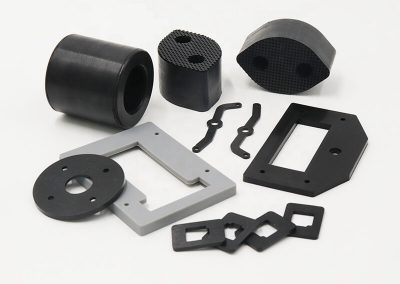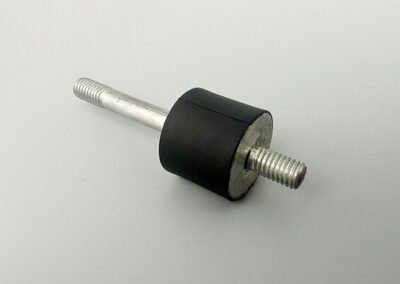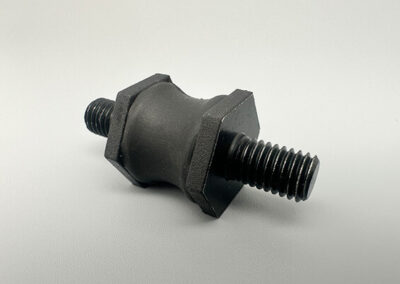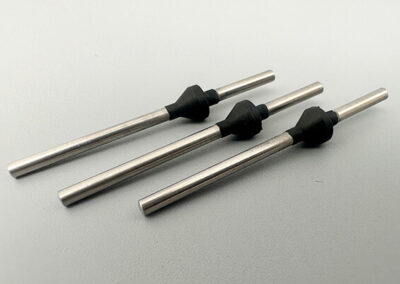Manufacturing Rubber Products
Overmolding and Insert Molding for Rubber Metal Parts

At Sungplastic, we create high-performance rubber components with a precision rubber parts manufacturing process. With many years experiences of manufacturing rubber products, we have established trust relationships with different customers in several countries. If needed, we are ready to solve the manufacturing problems for you.
Please read on to learn about the steps of manufacturing rubber products and the processes required to bring them to life.
Manufacturing Rubber Products Processes
Manufacturing rubber products involves several processes that transform raw rubber materials into finished goods. These processes can vary depending on the type of rubber being used and the specific product being manufactured. Here are the rubber manufacturing services we will support you.
Compression Molding
In this method, the rubber compound is placed into a mold cavity, and pressure is applied to compress the material into the desired shape. Heat is also applied to cure the rubber. Compression molding is used for products like gaskets, seals, and automotive parts.
Injection Molding
Injection molding involves injecting molten rubber into a mold under high pressure. This process is suitable for complex and precise parts, such as automotive components and consumer goods. There are also common overmolding and insert molding, which is to put the completed metal parts into the mold cavity, and then mold them with the rubber injected into the mold.
Transfer Molding
Transfer molding combines elements of compression and injection molding. A measured amount of rubber is placed in a heated chamber, and a plunger forces the material into a mold cavity. It’s commonly used for electrical connectors, grommets, and small precision parts.
Extrusion
Extrusion is used for creating continuous lengths of rubber with a specific cross-sectional shape, such as hoses, tubing, and profiles. The rubber is forced through a die to achieve the desired shape.
Curing
Curing, also known as vulcanization, is the process of cross-linking the rubber polymer chains to enhance its strength, elasticity, and heat resistance. This is typically achieved by applying heat and pressure to the molded rubber product. Common curing methods include steam, hot air, and microwave curing.
Rubber to Metal Bonding
Rubber to metal bonding is a specialized process used to create products that combine the flexibility and resilience of rubber with the strength and stability of metal. The rubber component, which is typically preformed or molded, is then positioned onto the metal surface with the adhesive. The assembly is subjected to heat and pressure in a process known as vulcanization or curing. This process chemically bonds the rubber to the metal, creating a strong and durable connection. This process is essential in applications where both vibration dampening and structural support are required.
Compounding
Compounding is the process of mixing raw rubber materials with various additives to create a rubber compound with specific properties. Additives can include curing agents, accelerators, antioxidants, fillers, plasticizers, and colorants. The mixing is typically done in a two-roll mill or an internal mixer to ensure uniform distribution of additives.
Milling
After compounding, the rubber compound is typically passed through a series of mills or mixers to further homogenize and shape the material. This step helps remove any air bubbles and ensures uniformity in the compound.
Post-Processing
After curing, the rubber product may undergo additional processes like trimming, deflashing (removing excess material), and surface treatments (e.g., coatings or polishing) to meet specific requirements.
Rubber Molding Materials
Each type of rubber has its unique set of properties, making it suitable for specific applications. The choice of rubber material depends on factors such as the intended use, environmental conditions, temperature, chemical exposure, and desired physical characteristics.
Understanding the characteristics of different rubber types is crucial for selecting the right material for a given application. The primary types of rubber include:
Natural Rubber (NR)
Natural rubber is derived from the latex sap of the rubber tree, Hevea brasiliensis. It is known for its high elasticity and resilience. Natural rubber is commonly used in applications like tires, footwear, and various consumer products. However, it has limited resistance to heat and chemicals.
Synthetic Rubber
Synthetic rubbers are artificially created through chemical processes. There are several types of synthetic rubbers, including:
-
- Styrene-Butadiene Rubber (SBR)
SBR is a widely used synthetic rubber due to its excellent abrasion resistance and durability. It is commonly found in automobile tires and conveyor belts. - Polybutadiene Rubber (BR)
Polybutadiene rubber is valued for its high resilience and low-temperature flexibility. It is often used in tire manufacturing and as an impact modifier in plastics. - Nitrile Rubber (NBR)
NBR exhibits exceptional resistance to oil, fuel, and chemicals, making it suitable for applications like seals, gaskets, and O-rings in the automotive and industrial sectors. - Butyl Rubber (IIR)
Butyl rubber is known for its impermeability to gases, making it ideal for tire inner tubes, inner linings for chemical storage tanks, and pharmaceutical stoppers. - Neoprene (CR)
Neoprene offers excellent resistance to weathering, ozone, and oil, making it a popular choice for wetsuits, hoses, and automotive gaskets. - Ethylene Propylene Diene Monomer (EPDM)
EPDM rubber is valued for its resistance to heat, weathering, and UV radiation. It is often used in roofing materials, automotive seals, and outdoor electrical insulation.
- Styrene-Butadiene Rubber (SBR)
Silicone Rubber (VMQ)
Silicone rubber is known for its excellent heat resistance and electrical insulation properties. It is commonly used in medical devices, cookware, automotive applications, and as a sealant.
Fluoroelastomers (FKM)
Fluoroelastomers, such as Viton, are highly resistant to chemicals, high temperatures, and oils. They are commonly found in applications requiring exceptional chemical resistance, like seals and gaskets in the chemical and aerospace industries.
Chloroprene Rubber (CR)
Chloroprene rubber, also known as Neoprene, offers good resistance to weathering and ozone. It is often used in applications requiring a balance of physical properties, like wetsuits and industrial belting.
Polyurethane (PU)
Polyurethane rubber combines the properties of rubber and plastic. It is appreciated for its abrasion resistance and load-bearing capacity, making it suitable for wheels, bushings, and industrial machinery components.
Common Rubber Products Applications
Rubber products are used in a wide range of applications across various industries due to their unique properties and versatility. Here are some common applications of manufacturing rubber products:
-
- Automotive Industry
Rubber is extensively used in the automotive sector for tires, hoses, seals, gaskets, suspension components, and engine mounts. It provides traction, noise isolation, and sealing properties. - Construction Industry
Rubber is used in construction for roofing materials, sealants, gaskets, and vibration isolation pads. It helps in waterproofing and reducing noise and vibrations. - Industrial Equipment
Rubber components like conveyor belts, grommets, bushings, and O-rings are essential in industrial machinery to ensure smooth operation and reduce wear and tear. - Consumer Goods
Rubber is found in everyday consumer products like footwear, toys, kitchenware, and sporting goods due to its comfort, flexibility, and shock absorption properties. - Healthcare and Medical Devices
Medical-grade rubber is used in applications such as surgical gloves, tubing, seals, and prosthetic limbs due to its biocompatibility and resistance to sterilization processes. - Electronics and Electrical
Rubber gaskets, insulators, and cable insulation materials are crucial in the electronics and electrical industries for sealing and insulating applications. - Aerospace and Defense
Rubber is used in aircraft and defense applications for seals, gaskets, vibration dampening, and shock absorption to ensure safety and performance. - Marine Industry
Rubber is used in marine applications for seals, gaskets, fenders, and anti-vibration mounts to withstand harsh marine environments. - Sporting Goods
Rubber is employed in the manufacturing of sports equipment like balls, grips, and protective gear due to its resilience and impact resistance.
- Automotive Industry
To browse more of our manufacturing experience, please click our product Gallery.
Professional Rubber Parts Manufacturer–Sungplastic
We specialize in manufacturing rubber products for many years, with advanced machinery and technologies, skilled workers, experienced and knowledgeable designers and engineering teams. About the cost of design, rubber material, processing and labour, we can provide a competitive price and are committed to manufacturing rubber products with high quality.
Bring us your ideas, and we will work with you to make sure your custom rubber parts are quickly created to your exact specifications.
Get a free quote and design analysis today.
We’ll reply to you within 6 working hours.
We respect your privacy.
+86 139 2927 4777 (WhatsApp, Wechat)
Related Rubber Parts Fabrication Resources
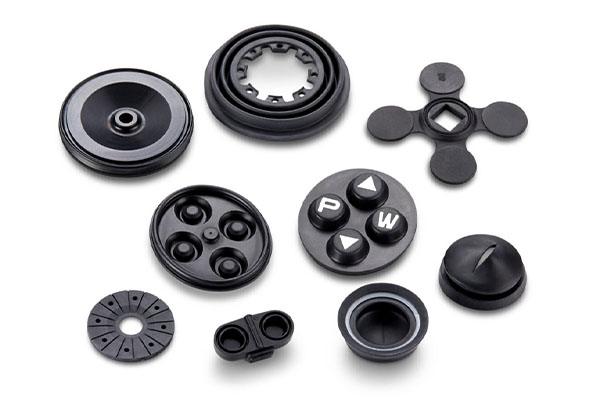
Rubber Molding: Custom Rubber Molded Parts Manufacturing
[pac_divi_table_of_contents...
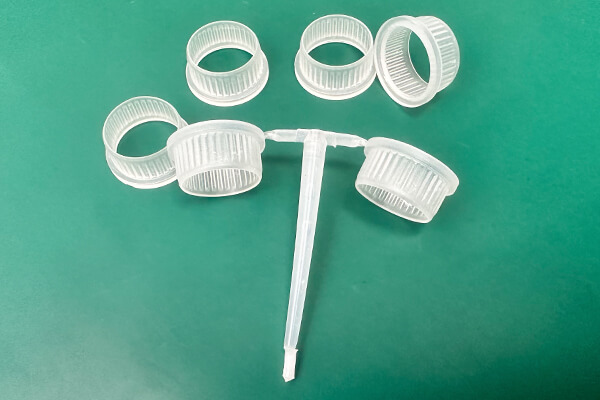
Polyurethane Injection Molding: Solutions for Custom PU Parts
[pac_divi_table_of_contents...
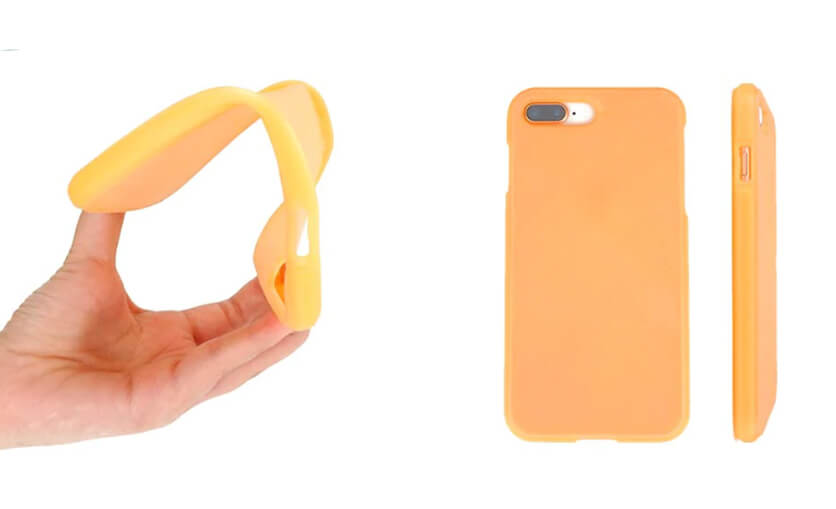
TPU Injection Molding: High Quality Plastic Parts
[pac_divi_table_of_contents...

